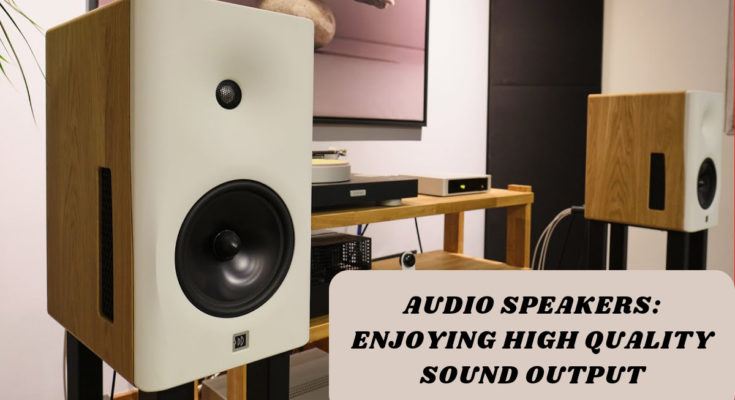AUDIO SPEAKERS :-
Audio speakers are devices that convert electrical signals into sound waves that can be heard by human ears. They are an essential component of any sound system, from simple desktop computer speakers to large, high-end home theater systems.
The basic principle behind a speaker is fairly simple. When an electrical current flows through a wire coil that is suspended in a magnetic field, it creates a magnetic field of its own. This causes the coil to move back and forth rapidly, which in turn causes a diaphragm (a thin, lightweight cone-shaped object) to vibrate. As the diaphragm vibrates, it pushes against the air in front of it, creating sound waves that travel through the air and into your ears.
Speakers come in a wide variety of sizes and designs, each with their own unique strengths and weaknesses. Some speakers are designed to be compact and portable, while others are meant to be permanently installed in a room. Some are designed for use in home theater systems, while others are optimized for use with music. There are also a variety of different technologies used in speaker design, such as dynamic drivers, electrostatic panels, and planar magnetic drivers.
When selecting speakers, it’s important to consider factors such as the size of the room, the type of music or sound being played, and the overall budget. With the right speakers, it’s possible to enjoy high-quality, immersive sound in your home or office.
AUDIO SPEAKERS: ENJOYING HIGH QUALITY SOUND OUTPUT
To enjoy high-quality sound output from your audio speakers, there are several factors to consider, including speaker placement, room acoustics, amplifier power, and speaker quality.
1. Speaker placement: Proper speaker placement is crucial for achieving the best sound quality. You should position your speakers so that they are at ear level when you are seated in your listening area. Ideally, your speakers should also be positioned equidistant from each other and from the walls.
2. Room acoustics: The acoustics of the room where your speakers are located can have a significant impact on sound quality. You can improve room acoustics by adding acoustic treatments, such as absorptive panels, diffusers, or bass traps. Alternatively, you can use room correction software to adjust the sound output to compensate for any acoustic issues.
3. Amplifier power: The power output of your amplifier should be matched to the sensitivity and impedance of your speakers. If your amplifier is underpowered, it may not be able to drive your speakers effectively, resulting in distorted or weak sound output.
4. Speaker quality: The quality of your speakers will also play a significant role in the overall sound quality. High-quality speakers will be designed to reproduce sound accurately and without distortion, with good frequency response and dynamic range. Consider investing in high-quality speakers from a reputable brand to get the best sound quality possible.
By taking these factors into consideration, you can set up your audio speakers for optimal sound quality and enjoy high-quality sound output for your music, movies, and other audio content.
TYPES :-
There are many types of audio speakers available on the market, each with their own unique features and characteristics. Here are some of the most common types of speakers:
1. Bookshelf speakers: These are small speakers that are designed to fit on a bookshelf or other small space. They are typically used in home theater systems or as part of a desktop audio system.
2. Floor-standing speakers: These are large, tall speakers that are designed to be placed on the floor. They are typically used in larger rooms or as part of a high-end home theater system.
3. In-wall speakers: These are speakers that are designed to be installed directly into a wall or ceiling, providing a discreet audio solution that blends in with the decor of the room.
4. Soundbars: These are long, narrow speakers that are designed to be placed below a TV or mounted on a wall. They are typically used as an all-in-one solution for home theater audio.
5. Portable speakers: These are small, battery-powered speakers that are designed for use on the go. They are typically Bluetooth-enabled, allowing you to stream music wirelessly from your smartphone or other device.
6. Outdoor speakers: These are speakers that are designed to be used outside, such as on a patio or by a pool. They are typically weather-resistant and designed to withstand exposure to the elements.
7. Studio monitors: These are high-quality speakers that are designed for use in recording studios, where accurate sound reproduction is crucial for mixing and mastering music.
These are just a few examples of the many types of audio speakers available on the market. When choosing speakers, it’s important to consider your specific needs and use case to find the best speakers for your situation.



